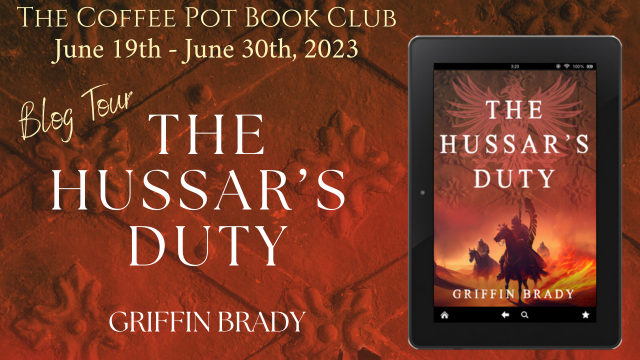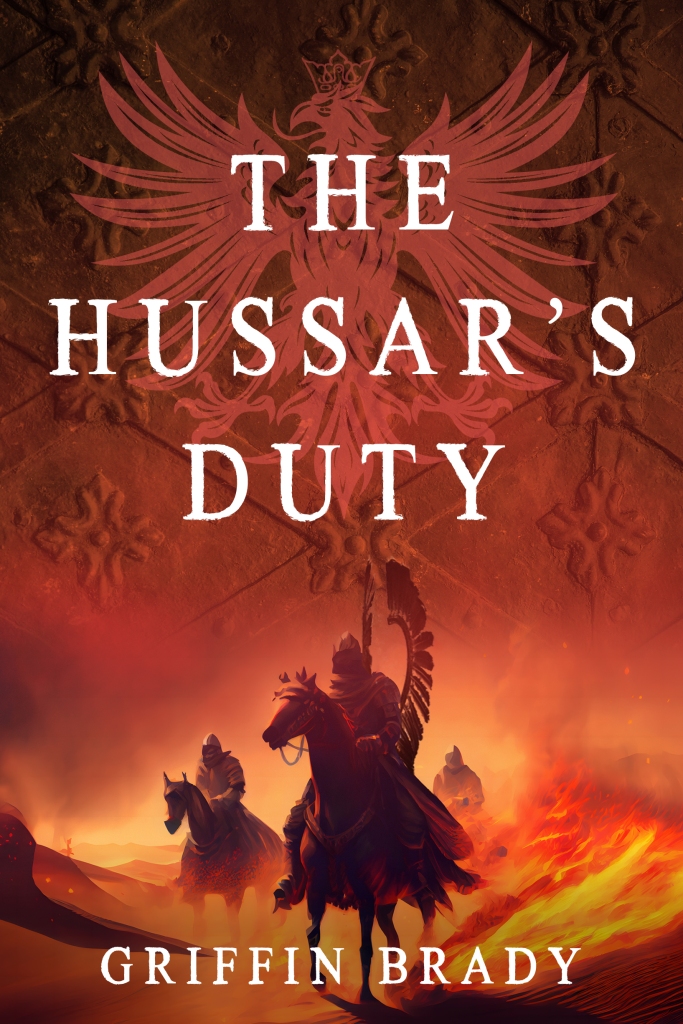Book Title: The Hussar’s Duty
Series: The Winged Warrior Series
Author: Griffin Brady
Publication Date: May 18, 2023
Publisher: Trefoil Publishing
Page Length: 538
Genre: Historical Fiction
Twitter Handle: @griffbrady1588 @cathiedunn
Instagram Handle: @thecoffeepotbookclub
Hashtags: #HistoricalFiction #WingedHussars #BlogTour #TheCoffeePotBookClub
Tour Schedule Page: https://thecoffeepotbookclub.blogspot.com/2023/04/blog-tour-hussars-duty-by-griffin-brady.html
Book Title and Author Name:
The Hussar’s Duty
by Griffin Brady
Blurb:
Poland’s most valiant winged hussar is called to fight in a campaign ripe for disaster. But he must also protect those he loves from jackals waiting to pounce. How does he choose between duty and devotion when death is on the line?
When Sultan Osman II sends Poland’s envoy packing, the Commonwealth must prepare for war against one of the largest armies the Ottomans have ever assembled. Tasked with repelling the invasion is Grand Hetman of the Crown Stanisław Żółkiewski, and he knows who to turn to: Jacek Dąbrowski, the Commonwealth’s most valiant Polish winged hussar.
Jacek has been idle far too long, and the call to arms is a siren’s song he can’t resist. But he has built a life far from the battlefield with his wife, Oliwia, and their children. If he pursues his quest for glory, who will safeguard them?
Oliwia knows her husband is restless. In fact, she’s been sending Jacek on cross-country errands for years in the hopes of quelling his lust for battle. When she realizes her efforts are futile, she resolves herself to letting him go—after hatching a scheme to accompany him.
Honor. Obligation. Devotion. These forces push and pull Jacek in different directions. His country needs him, but so does his family. Where does his duty lie? His choice will cause catastrophic ripples no matter which path he follows … and could very well bring the loss of his loved ones or his life.
Will the cost of defending king and country prove too steep for this warrior?
This is a standalone continuation in The Winged Warrior Series.
When Angels Fly
(Guest post linked to the series)
(With a lovely name like “When Angels Fly,” I had to go with a guest post about the Polished winged hussars’ most notable feature, their wings!)
When I think of the Polish Winged Hussars, many adjectives leap to my mind at once: Fierce. Flamboyant. Intimidating. Boisterous. Honorable. Savage. God-fearing. They walked with a swagger that came from knowing they were the best and they might die in the next battle.
Besides their prowess on the battlefield, though, what set them apart visually were those magnificent wings! Sadly, like their long hollow lances, they weren’t built to last, and most did not survive the ravages of time. The evidence of their existence can be found in paintings and sketches and the scant extant samples that did make it.
Did they really wear them, and why? According to narratives penned by those who witnessed the mighty hussars charging into an enemy line, the horsemen did sometimes wear them into battle. The wings might have been a single one attached to the back of a saddle or the iconic curved pair bolted to their backplates that curled above a warrior’s head.
*****
While experts agree the wings existed, how exactly they evolved and their purpose are even trickier questions. No one knows for sure, and in a rush to explain their existence, theory and conjecture abound.
To explore their possible origin, let’s travel back briefly to the 16th century to the rise of the hussars. After the Union of Lublin, which formed the Polish-Lithuanian Commonwealth in 1569, the Commonwealth’s southern borders came under attack from the Ottoman Empire. The Serbian and Hungarian territories were conquered, but a new type of soldier, a combination of Serbian and Hungarian, survived and soon would thrive in Poland: the hussar. The word hussar, in fact, harkens back to húsz, meaning twenty. It’s believed that the first hussars came from ranks of peasants, where one out of twenty was recruited into service.
The Hungarian hussar was armored, but the Serbian was not. The Serbians, however, carried a light lance and an asymmetrical shield with a wing painted on it, like the fine fellow below. The Polish Winged Hussar is a combination of the two.
*****
In 1576, Stefan Bathory, a Transylvanian prince, was elected king of Poland. It was he who standardized the Poles’ equipment so it matched his personal guard of Transylvanian and Hungarian hussars, giving rise to the Polish Winged Hussars. The shields were abandoned in favor of heavier armor, and the wings became more than artwork.
So why did they adopt the wings?
Some theorize they donned them because the noise would have frightened enemy horses. But consider that the thunder of their hoofbeats as they charged at an enemy line would have drowned out the sound.
Others speculate the wings made it difficult for Tatars to get a lasso around their torsos and drag them off their horses. If you’ve read The Heart of a Hussar, you know I like that theory myself, though history offers no proof.
How about psychological warfare as a reason for wearing the wings? It’s hard to know what effect the visual of those shuddering wings would have had on enemy horses, but it must have been terrifying to be a soldier on the front line while a wall of winged cavalrymen was bearing down. Not only would the defender have seen the horrifying sight coming at him, he would have felt the vibration of the hoofbeats through the ground. The hussars would have appeared larger than life, like archangels.
Given their deep sense of religion, I imagine the hussars would have taken pride in being compared to archangels. They certainly lived and breathed the notion that they were the “Bulwark of Christendom,” fighting for their Catholic God and country.
Another explanation for the wings has nothing to do with battle. Some surmise they were one more accoutrement that bespoke the splendor of the hussar and were worn mainly for parades and the like. In other words, it might have been plain old vanity. These men were peacocks, and they dressed in their finery before meeting the enemy on the battlefield, so the theory definitely has merit.
Whatever the reason, the wings set the Polish Winged Hussars apart from other cavalry of their day and lend them an air of timelessness that continues to fascinate.
Buy Links:
This title is available to read on #KindleUnlimited.
Universal Link: https://readerlinks.com/l/3336453
Amazon US: https://www.amazon.com/dp/B0C2VZ2963/
Amazon UK: https://www.amazon.co.uk/dp/B0C2VZ2963/
Amazon AU: https://www.amazon.com.au/dp/B0C2VZ2963/
Amazon CA: https://www.amazon.ca/dp/B0C2VZ2963/
Author Bio:
Griffin Brady is an award-winning historical fiction author with a keen interest in the Polish Winged Hussars of the 16th and 17th centuries. She is a member of the Historical Novel Society and Rocky Mountain Fiction Writers. Her debut novel, The Heart of a Hussar, was a finalist for the 2021 Chaucer Early Historical Fiction Award and a 2021 Discovered Diamond.
The proud mother three grown sons, she lives in Colorado with her husband. She is also an award-winning bestselling romance author who writes under the pen name G.K. Brady.
Social Media Links:
Website: https://www.griffin-brady.com/historical-fiction/
Twitter: https://twitter.com/griffbrady1588
Facebook: https://www.facebook.com/AuthorGriffinBrady
Book Bub: https://www.bookbub.com/profile/griffin-brady
Amazon Author Page: https://www.amazon.com/author/griffinbrady
Goodreads: https://www.goodreads.com/author/show/20675881.Griffin_Brady



Thank you for hosting Griffin Brady today, with such a fascinating guest post about the Hussars.
Cathie xo
The Coffee Pot Book Club
LikeLiked by 3 people
Welcome, Cathie
LikeLike